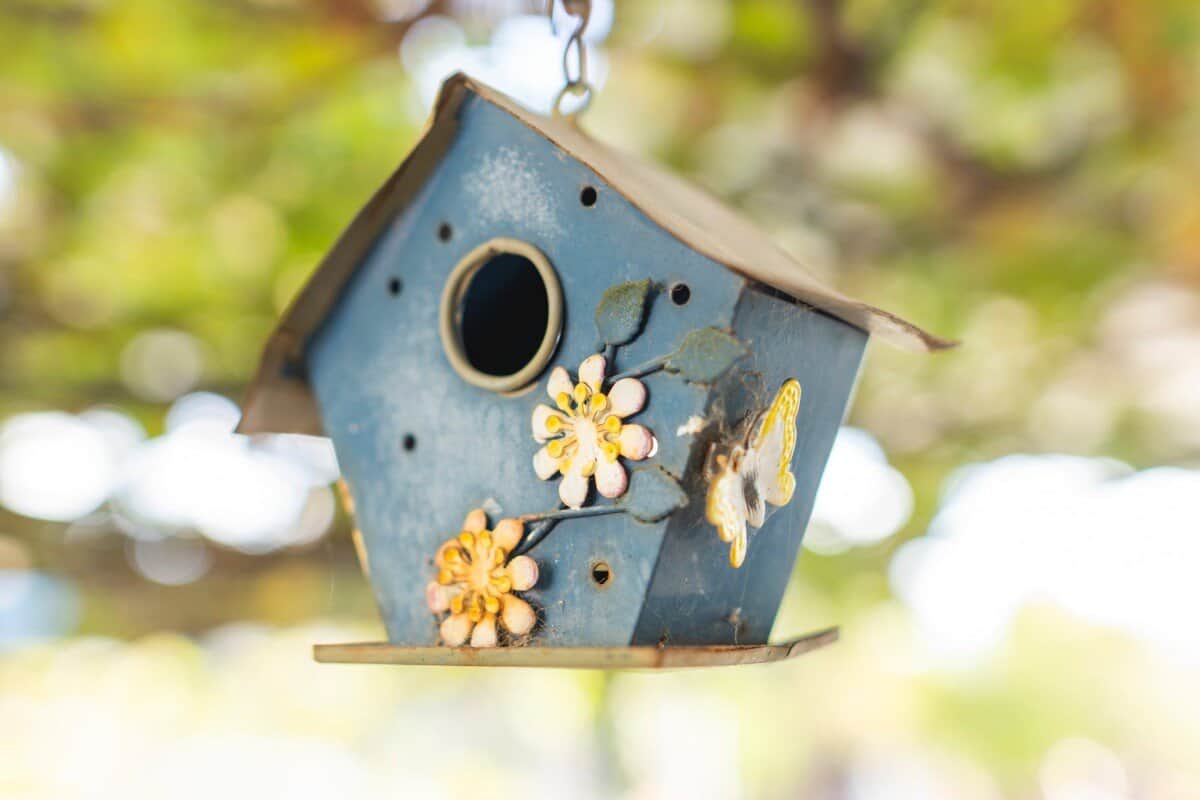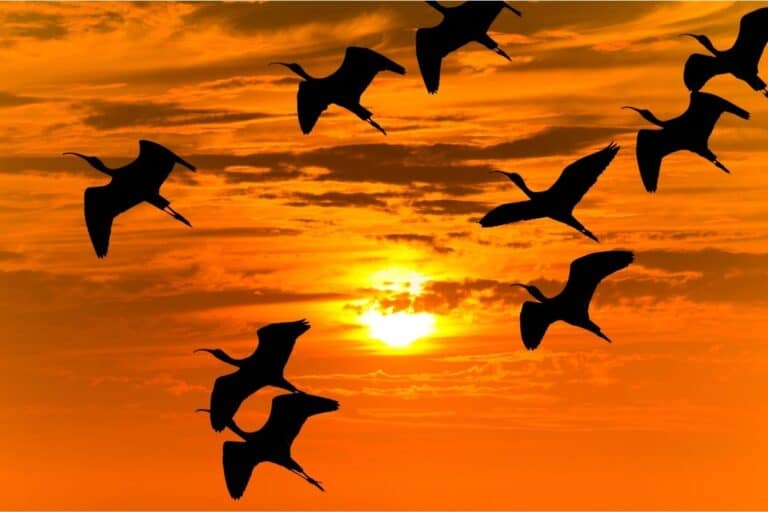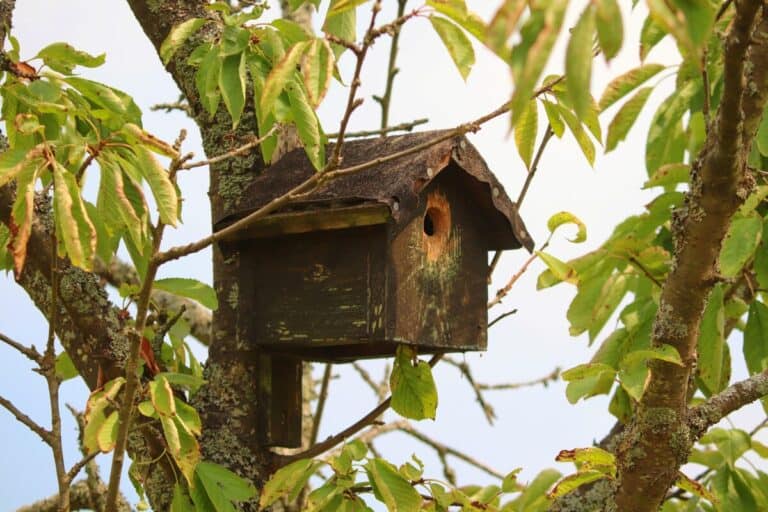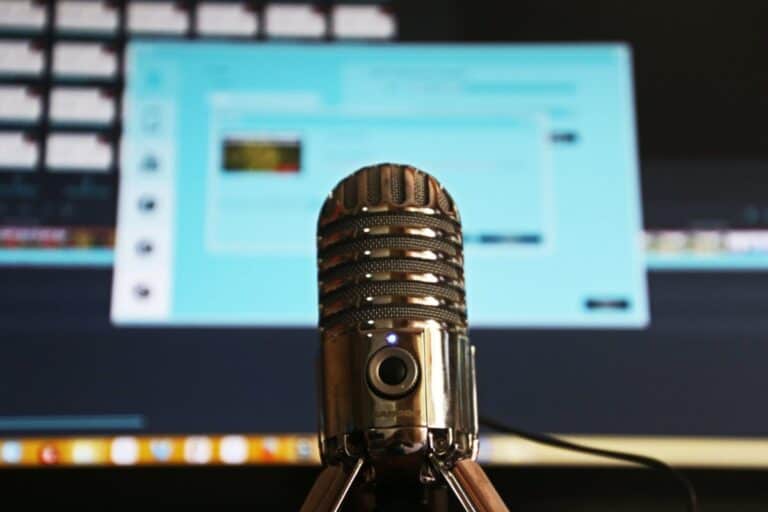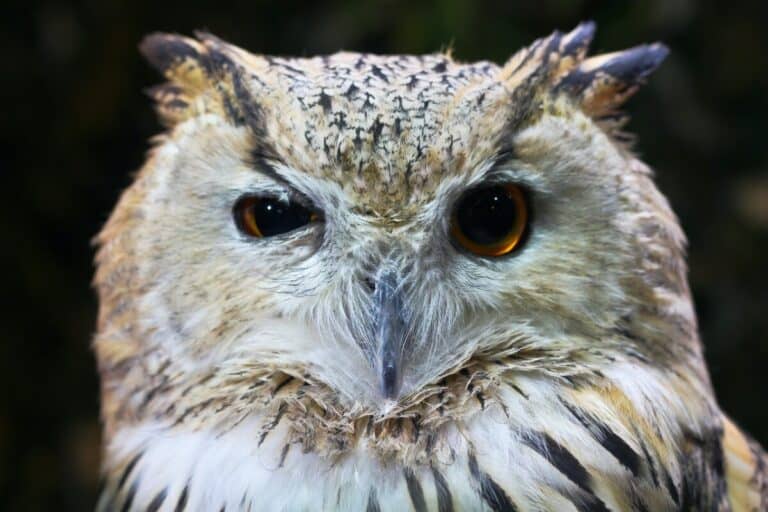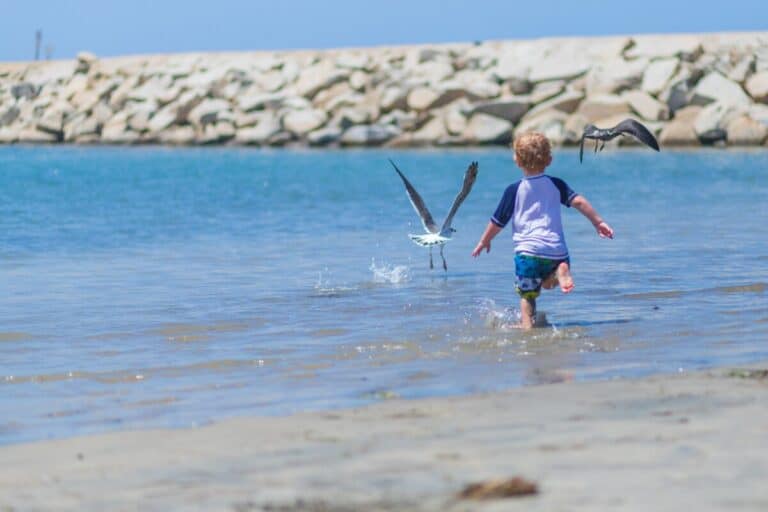The Best Location For A Bird House (With Helpful Examples)
We’re reader-supported; we may earn a commission from links in this article.
Maybe you’ve seen others keep really nice birdhouses outside their backyards and you’ve always wanted to try to set up your own.
I was also thinking about setting up a birdhouse for myself and didn’t really find any comprehensive guide online for it, so I decided to write one for myself.
So I did a little research online and here’s what I found:
The best location for a birdhouse is to be mounted on a pole. This pole must be 5 to 30 feet off the ground and away from trees and predators. The best location for a birdhouse also needs to be concealed using camouflage. The best birdhouse locations differ between different bird species according to their needs.
As the specifics of birdhouse placement and location differ between different species, there are certain caveats that need we need to consider when choosing a location for the bird that you intend to house. Read on to find out more!
General Considerations In Setting Up A Birdhouse
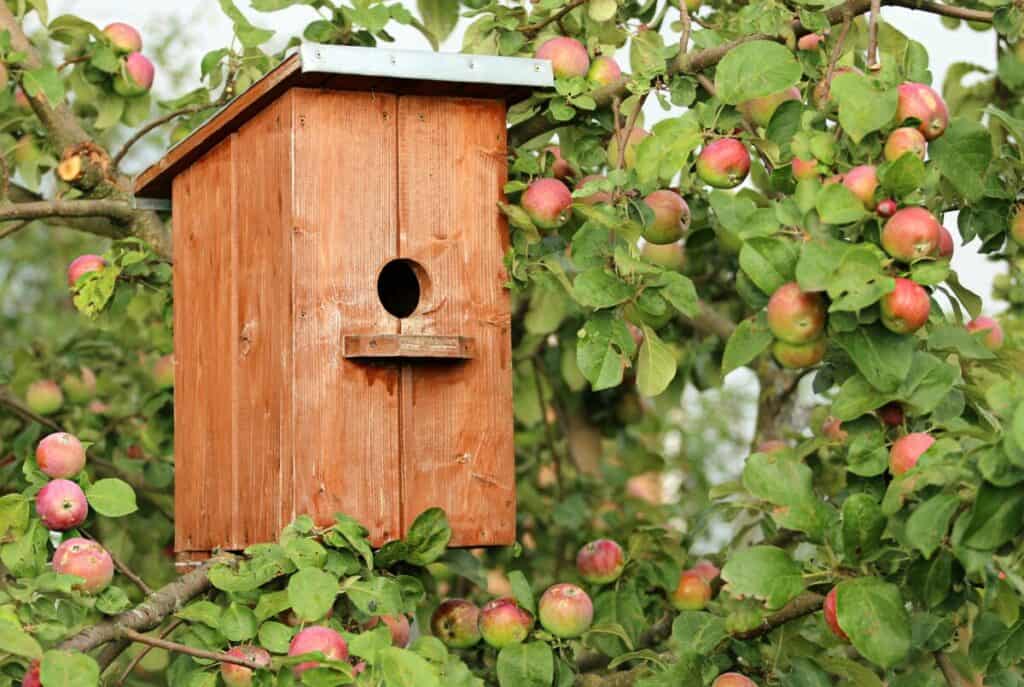
In setting up a birdhouse, there are some considerations that you may want to take note of before we dive into the specifics and details. Here we go:
1) Accessible to Bird Watchers
While birdhouse protection from predators and the adoption rate is useful for the birds, it is also equally important for the birdhouse to be accessible for bird watchers to observe and maintain. The birdhouse needs to be placed in a location where bird watchers can provide upkeep and cleaning out of the birdhouse when it is emptied.
2) Nesting Materials
Generally, the birdhouse has to be furnished with some nesting materials to make it comfortable for birds. Examples of such materials are pine needles, feathers, twigs and sticks, dead grass, yarn, string, and thread. Different bird species will require different nesting materials, so you should keep that in mind too.
3) Birdhouses Should be Spaced Apart
Birdhouses should be spaced apart so that they allow for privacy and space from other birds’ nests. A rule of thumb to follow is at least 25 feet apart. Birds may be territorial, so you would have to keep to the distancing to ensure the birds are comfortable in their birdhouses.
4) Shading From The Sun is Not Required
Shading from the sun is not a requirement but provides some protection from the afternoon sun. However, keep in mind the color of the birdhouse so that the birdhouse won’t overheat in the summertime. As a rule of thumb, make sure it’s not black.
Where To Place Your Bird House?
Typically, a birdhouse is usually placed in a set few locations. These locations each have their own differences in preventing predators, ease of maintenance, and durability. Let’s go through the different ways a birdhouse can be set up.
1) Mounted On A Pole
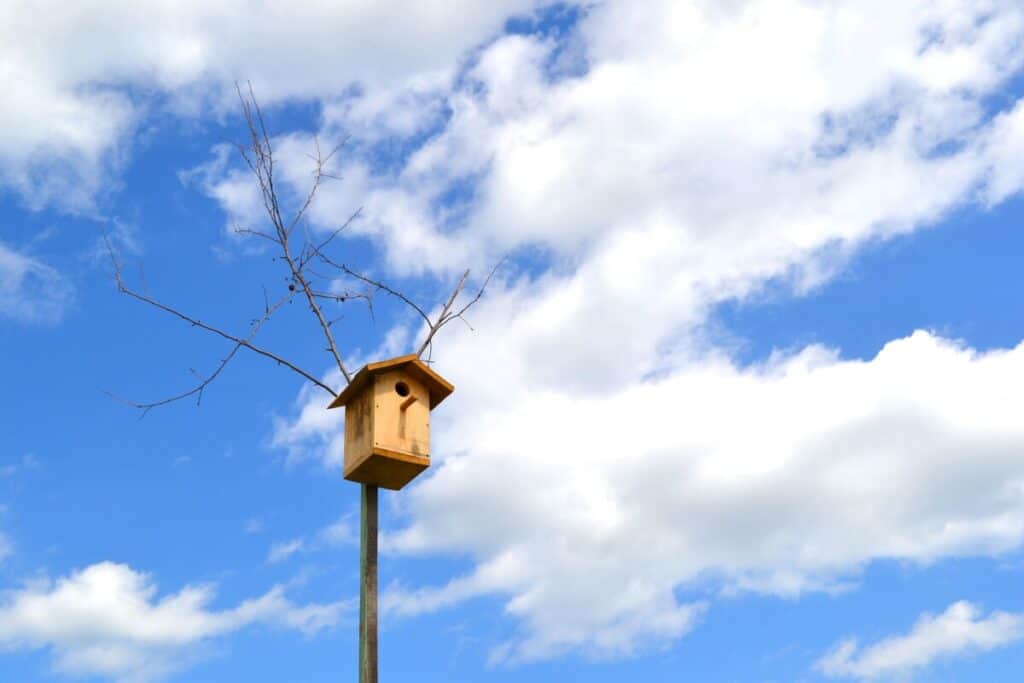
Setting up a birdhouse on a pole is one of the most ideal locations and places to mount a birdhouse. This is because of its inaccessibility to predators that hunt the birds that will potentially stay in the birdhouse.
Examples of predators that are deterred are snakes, cats, squirrels, etc. If you choose to set up a pole with a smooth finish such as metal, then the pole would be virtually impossible for most predators to climb up.
However, one thing to take note of would be to not set up the pole near any tall trees as squirrels and snakes will still have access to it. A good distance away would be about 10 feet away.
Squirrels are able to jump quite a distance, so wouldn’t want them ruining the birdhouse. Some snakes are long enough to breach a short distance, so you also wouldn’t want them reaching across and eating up your bird’s eggs.
2) A Slippery Building Edge
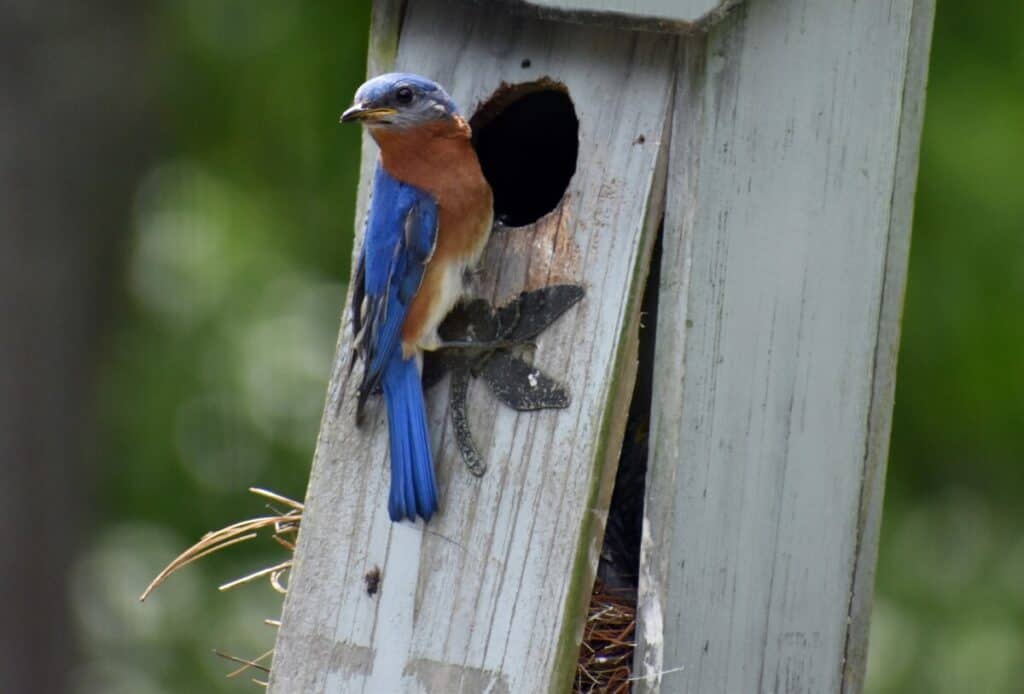
What I mean by a slippery building edge is the edge of a preferably slanted edge on top of a building. It would be better if this edge has a metal material, which will add to the slippery factor. The slippery facade will prove useful in preventing predators such as squirrels from going near it.
As this birdhouse will be placed on a building, you would have to keep the exposure to heat in mind. As such, if the side is facing the sun, you may end up getting the birdhouse overheated.
A piece of advice would be to paint it in a color that isn’t black and does not face the opening of the birdhouse toward the sun.
How you can do this is to determine the North and South, and place it in either direction. (This principle is due to the sun rising in the east and setting in the west.)
3) Tree Trunks
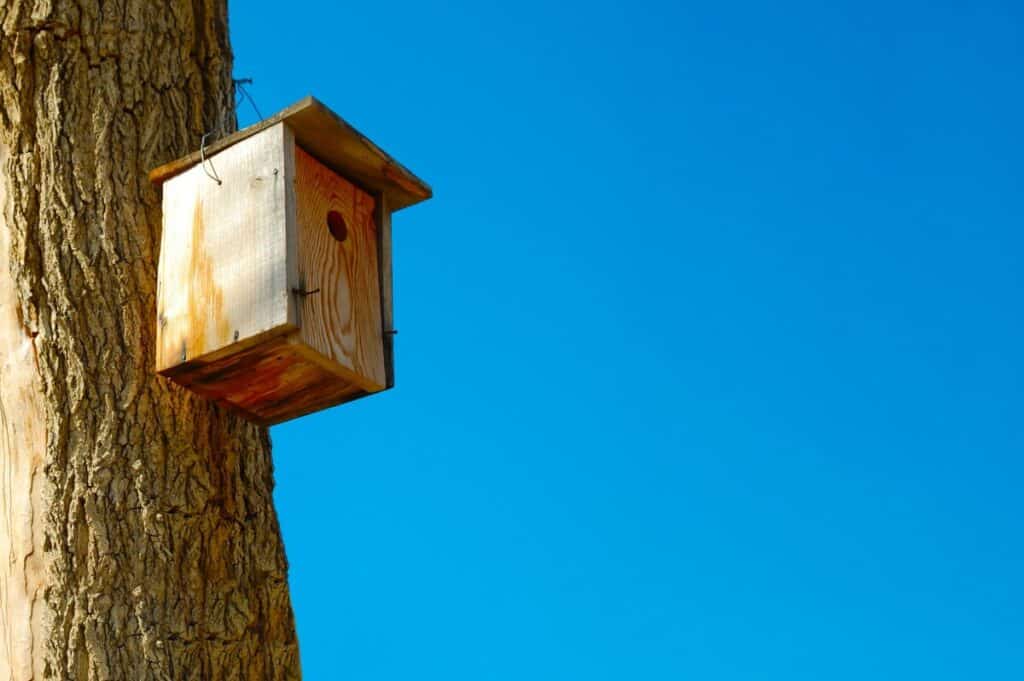
Placing your birdhouse on a tree trunk would serve as a very stable option for its instalment in the long term. This option can be considered if you do not have the option of mounting the birdhouse on a pole or on a slippery edge of a building.
Please keep in mind that birdhouses on tree trunks are one the most accessible locations for predators to climb up and into.
If you really need to mount it on a tree trunk, then I suggest that you ensure that the entrance hole is kept as small as possible to only allow birds to enter.
There is evidence that grey and red squirrels will attempt to climb into such birdhouses and consume bird eggs and fledglings too. It is important that you get this step right, if not the nest would be for naught.
4) Hang It From A Height
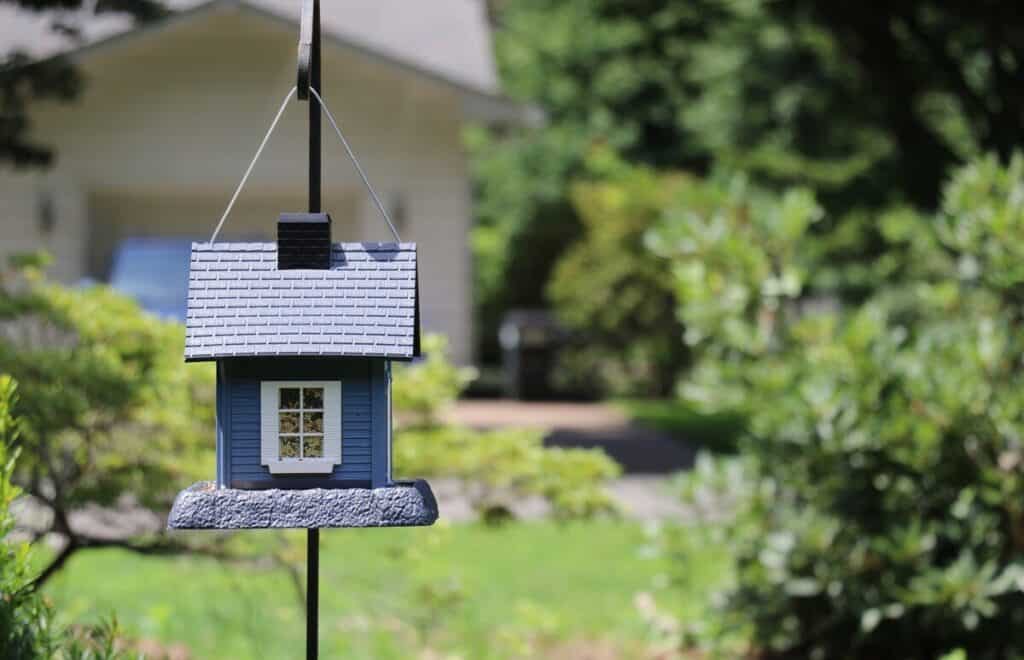
You can choose to install your birdhouse by hanging it from a height. This can be in the form of a tree of any other structure from a height and dangled down with a wire, sturdy rope, or chain. One thing to note for this type of birdhouse placement is that it is prone to wild swinging on a windy day. This may not be too ideal for birds to brood and set up a safe nest. One action you can take to prevent this is to keep the length of the wire as short as possible to minimize swaying.
As this birdhouse is kept in the range of another structure, this placement is susceptible to predators that can access the structure, especially if this is a tree. You will need to keep this in mind when choosing this method.
With regards to maintenance, hanging out your birdhouse may require a more difficult maintenance process. You will need to monitor the condition of the wire, rope, or chain to ensure it will not snap and drop the birdhouse.
If the wire, rope, or chain grows weak, it may be difficult to replace too. Birds may have already inhabited the birdhouse at the point in time, so you would have to wait until they vacate the birdhouse for migrating before changing out the wire, rope, or chain of choice.
Different Ideal Habitats Of Different Bird Species
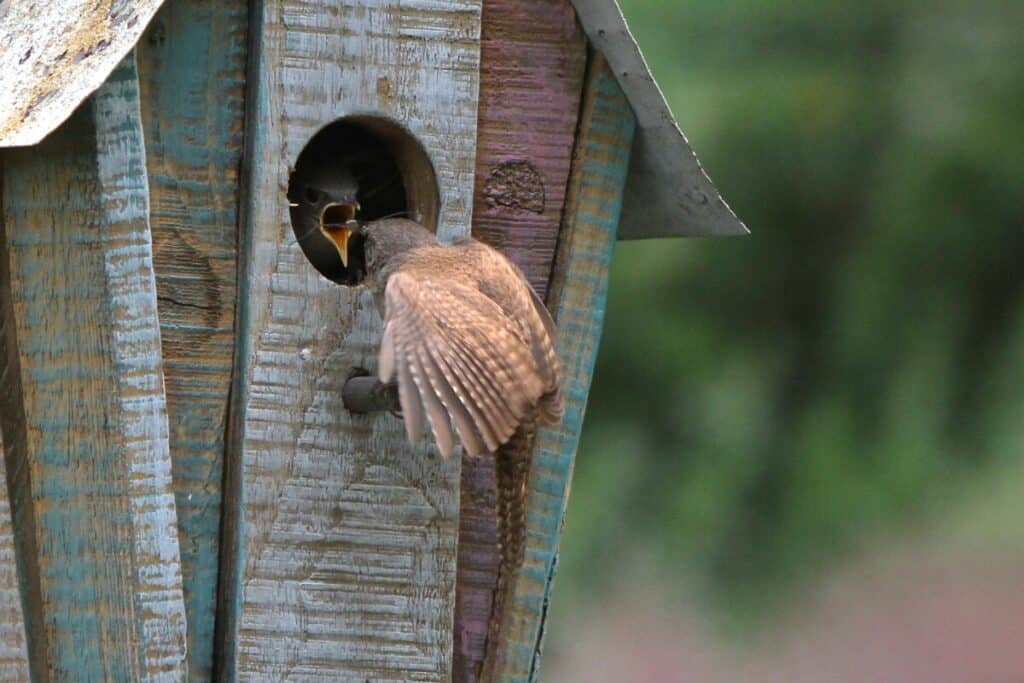
Depending on the bird species that you would like to attract to your birdhouse, you will need to think of the best habitat to mount your birdhouse. Here, I’ve summarized the different ideal locations for different bird species in a table for your convenience:
| Bird Species | Ideal Birdhouse Habitat |
| Bluebird | open field or lawn; orchards; open, rural country with scattered trees and low or sparse ground cover |
| Purple Martin | deciduous and coniferous forest edges |
| Wood Duck | forested wetlands or near marshes, swamps, and beaver ponds |
| American Kestrel | pastures, fields, meadows, or orchards with mowed or grazed vegetation |
| Eastern Screech Owl | forests, parks, woodland clearings, forest edges, wooded stream edges, under a tree limb |
| Western Screech Owl | lower elevations, forests, parks, woodland clearings, forest edges, deserts, wooded stream edges, under a tree limb |
| Great Crested Flycatcher | deciduous or mixed deciduous-coniferous forests, forest edges, woodlots, orchards, parks, on post or tree at forest edge |
| Ash-throated Flycatcher | chaparral, mesquite thickets, oak scrub, dry plains spotted with trees or cacti, deserts |
| Northern Flicker | pastures, groves, woodlots, orchards, fields, meadows, woodland clearings, forest edges, urban parks, on pole or tree at forest edge or along fence rows bordering crop fields |
| Tree Swallow | open fields near water, expansive open areas, marshes, meadows, wooded swamps |
| Violet-green Swallow | open or broken deciduous or mixed deciduous-coniferous forests, wooded canyons, edges of dense forest |
| Tufted Titmouse | deciduous forest, thick timber stands, woodland clearings, forest edges, woodlots, riparian and mesquite habitats |
| Black-capped Chickadee | forests, woodlots, and yards with mature hardwood trees, forest edges, meadows, |
| Carolina Chickadee | forests, woodlots, and yards with mature hardwood trees, forest edges, meadows |
| Mountain Chickadee | coniferous forests, forest edges, woodland clearings |
| Chestnut-backed Chickadee | coniferous forests, mixed deciduous-coniferous forests, forest edges, woodlands, thickets, burned areas, often near streams |
| Red-breasted Nuthatch | mixed coniferous-deciduous forests, shrub lands, swamps, farmlands, suburban parks |
| White-breasted Nuthatch | deciduous woodlands, mature forests, woodlots, near open areas, forest edges, orchards, often near water |
| Brown-headed Nuthatch | open stands of pine-hardwood forests, clearings scattered with dead trees, forest edges, burned areas, cypress swamps |
| Carolina Wren | forests with thick underbrush, forest edges, woodland clearings, open forests, shrub lands, suburban gardens, parks, backyards |
| House Wren | variety of habitats, farmland, openings, open forests, forest edges, shrub lands, suburban gardens, parks, backyards |
| Prothonotary Warbler | lowland hardwood forests subject to flooding, stagnant water, swamps, ponds, marshes, streams, flooded river valleys |
| Hooded Merganser | quiet, shallow, clear water pools surrounded by or near the edge of deciduous woods |
As seen in the table above, different bird species live in different natural habitats, so it is important that you set up your birdhouse in a location that is as similar to their natural habitat as possible. This will give the birds the protection that they require.
Optimum Birdhouse Mounting Heights
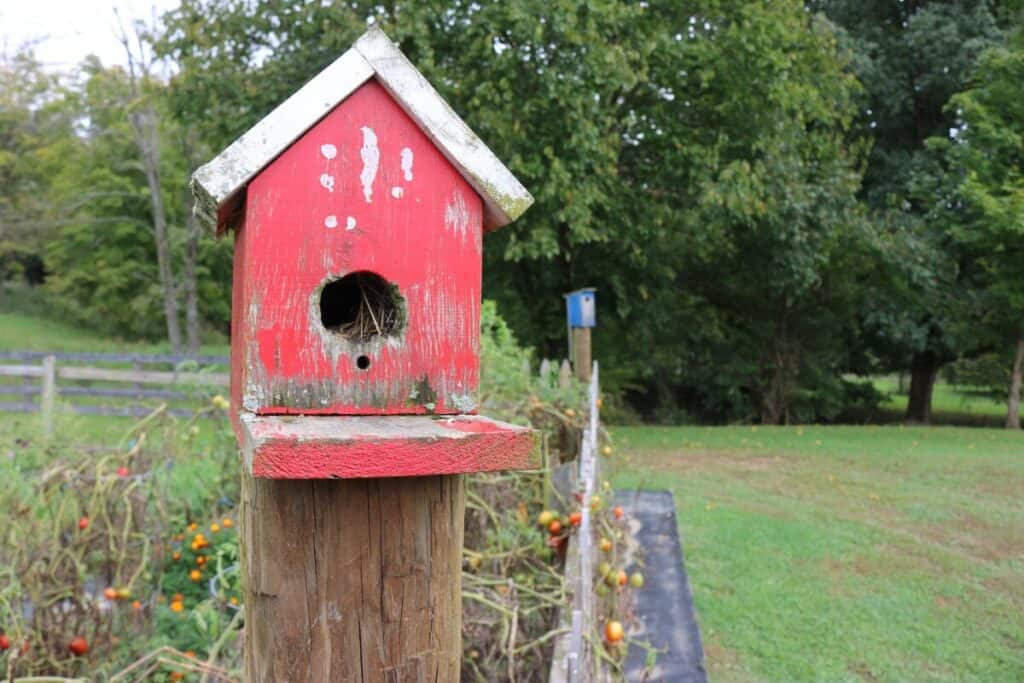
Although I mentioned that all birdhouses should be mounted from a 5 to 30 feet height, this range is simply too large to be applied in practicality. As such, different bird species require different optimum birdhouse mounting heights. These are to emulate their natural nesting elevations, so you would get a higher birdhouse adoption rate! Here’s a simple table of it so you can quickly refer to it for the bird species of your choice:
| Bird Species | Mounting Height |
| Bluebird | 5-6″ (1-2m) |
| Chickadee | 5-15″ (2-5m) |
| Flicker | 6-10″ (2-3m) |
| House Finch | 5-10″ (2-3m) |
| House Sparrow | 10-15″ (3-5m) |
| Kestrel | 10-20″ (3-6m) |
| Nuthatches | 10-15″ (3-5m) |
| Owl | 10-15″ (3-5m) |
| Purple Martin | 10-15″ (3-5m) |
| Tree Swallow | 5-10″ (2-3m) |
| Warbler | 5-10″ (2-3m) |
| Woodpecker | 10-20″ (3-6m) |
| Wren | 6-10″ (2-3m) |
Where to Place a Bird House?
Generally, it is best to place the birdhouse in a location that is away from direct sunlight and wind, but still within sight. A tree or sturdy post can provide stability and support for the house. Additionally, make sure the entrance of the house faces away from prevailing winds and that there are nearby trees or shrubs which may provide shade and protection.
Where is the Best Place to Put a Bird House?
Generally, it is best to place the birdhouse in an open area, such as a clearing or meadow, that is away from direct sunlight and strong winds. The entrance of the house should face away from prevailing winds and have nearby trees or shrubs that provide shade and protection.
Additionally, it is important to make sure there are perches nearby for the birds to rest upon. Finally, make sure the birdhouse is securely attached so it does not sway or fall when there is heavy wind.
Where to Hang Bird Houses?
The best place to hang a birdhouse is near an open area with nearby trees or shrubs for shade and protection. Avoid direct sunlight and strong wind and make sure the entrance faces away from prevailing winds. Securely attach the birdhouse to a tree or sturdy post. Nearby perches will provide a rest spot for the birds.
Final Thoughts
Birdhouses are the potential nests of birds, so they need to be placed in the right locations to ensure that the birds can brood in peace. It is important to get he location right, and even tailored down to the bird species so that the birdhouse that you set up is ready for a bird to settle in. Thanks for reading and all the best in placing your birdhouses!
Happy birding!
My Recommended Birding Resources:
Hey there, Justin here!
Here’s a list of all my favorite resources, products, and brands I trust and love.
My Celestron Nature DX 8×42 Binoculars: It’s a great budget pair for beginner birders. Highly valued for its price! Read my review.
Safe Paint for Bird Baths Guide: Learn about non-toxic paint for painting bird baths.
Safe Sealers for Bird Baths Guide: Learn which sealers are safe for bird baths.
Safe Paint for Bird Feeders Guide: Learn what special care needs to be taken to paint bird feeders with the right paint.
Safe Paint for Birdhouses Guide: Learn about non-toxic paint for painting birdhouses. (Not the same as bird baths!)
Bird Identification Apps Guide: 2 of my favorite birding apps are Merlin Bird ID, and eBird Mobile! Merlin is great for tracking and identifying birds, and eBird Mobile is great for tracking the birds sighted when birding.
Check out my resources page for the full list of resources I recommend!

Justin Chia
Justin is the founder and author of Birding Outdoors. He is a Nanyang Technological University (NTU) alumnus with a Bachelor of Biological Sciences and a former data analyst.
Now, Justin runs the Birding Outdoors blog full-time, hoping to share his deep love for birds, birding, and nature with others.
To unwind, Justin enjoys gaming and reading.

